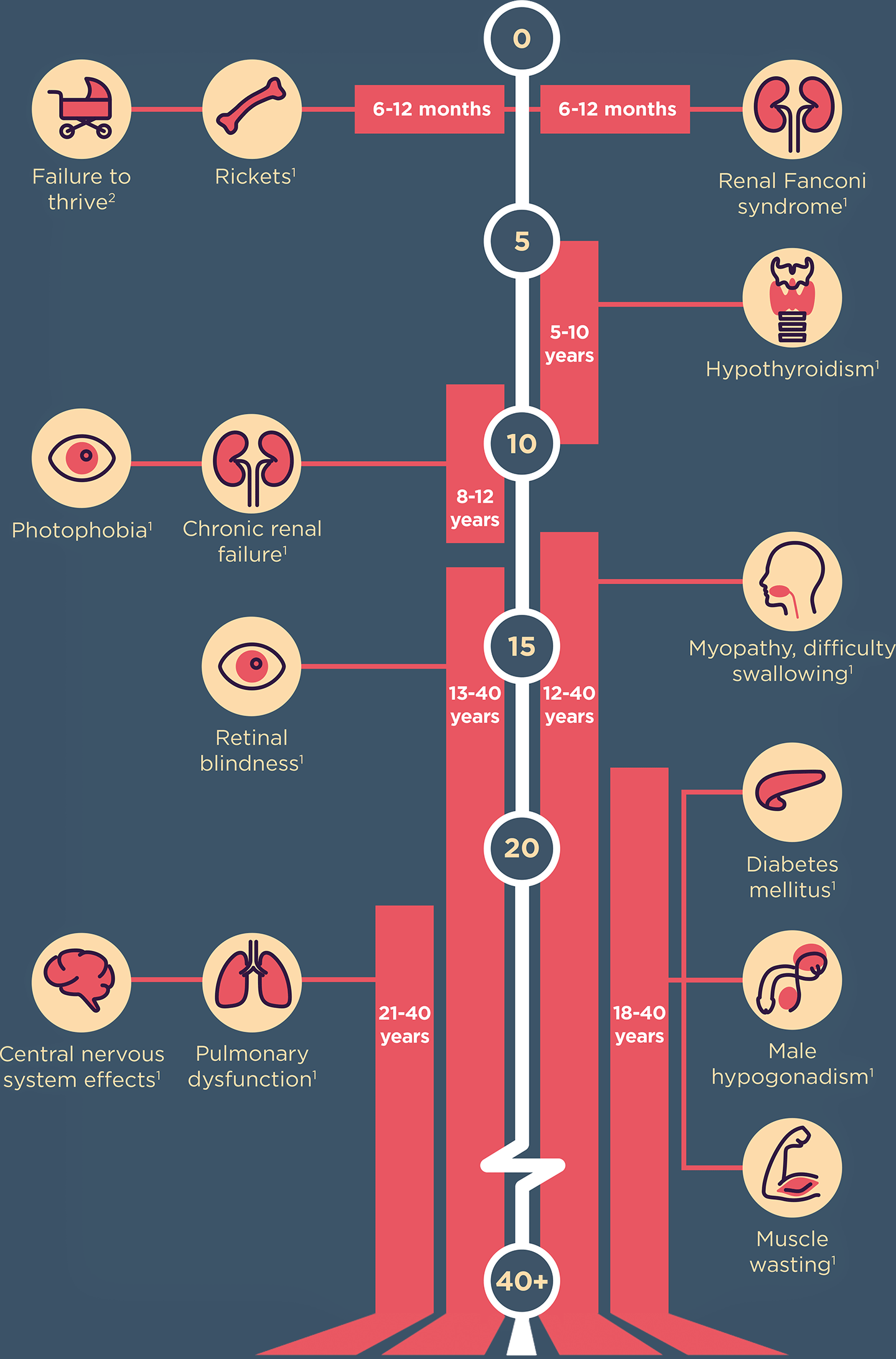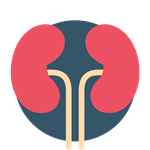
Identifying symptoms
Symptoms
Cystine accumulation leads to continuous damage in multiple organs over time. The multisystemic renal and extra-renal complications of nephropathic cystinosis build throughout life.1,2
Neonates are clinically asymptomatic at birth with normal birth weight and length, even though cystine accumulation begins in utero. Symptoms gradually develop during the first months of life.1
Timeline shows age of onset of complications in patients not receiving therapy

Figure adapted from Levtchenko E, et al. 20221 and Bäumner S, et al, 2018.2
Timeline shows age of onset of complications in patients not receiving therapy

Figure adapted from Levtchenko E, et al. 20221 and Bäumner S, et al, 2018.2
Early symptoms
6-12
months
Renal Fanconi syndrome2
Fanconi syndrome is ‘A dysfunction of the proximal tubule that leads to polydipsia, polyuria, dehydration, proximal renal tubular acidosis, urinary loss of electrolytes, and growth retardation.
As cystinosis is the most common reason for Fanconi syndrome at this age, this differential diagnosis should always be considered.
Less common reasons for secondary Fanconi syndrome include: Dent’s disease, Lowe’s syndrome, inherited fructose intolerance, galactosaemia and tyrosinaemia.
•
Growth retardation
At birth, patients show normal birth length and weight parameters. By the age of 6 to 12 months, height drops to the third percentile, and further growth is at low velocity.3
•
Rickets
Increased urinary loss of phosphate, calcium, and disturbances in vitamin D metabolism cause hypophosphataemic rickets in cystinosis patients.2
Cystinosis should be suspected in all patients with failure to thrive and signs of renal Fanconi syndrome.2
Fanconi syndrome is ‘A dysfunction of the proximal tubule that leads to polydipsia, polyuria, dehydration, proximal renal tubular acidosis, urinary loss of electrolytes, and growth retardation.
As cystinosis is the most common reason for Fanconi syndrome at this age, this differential diagnosis should always be considered.
Less common reasons for secondary Fanconi syndrome include: Dent’s disease, Lowe’s syndrome, inherited fructose intolerance, galactosaemia and tyrosinaemia.
•
Growth retardation
At birth, patients show normal birth length and weight parameters. By the age of 6 to 12 months, height drops to the third percentile, and further growth is at low velocity.3
•
Rickets
Increased urinary loss of phosphate, calcium, and disturbances in vitamin D metabolism cause hypophosphataemic rickets in cystinosis patients.2
Cystinosis should be suspected in all patients with failure to thrive and signs of renal Fanconi syndrome.2
1-2
years
Corneal cystine crystal accumulation
Corneal cystine crystals are absent at birth and generally can be observed by an experienced ophthalmologist with slit lamp examination starting at the age of 1.
Corneal crystals are always present after 16 months of age.
Corneal cystine crystals are absent at birth and generally can be observed by an experienced ophthalmologist with slit lamp examination starting at the age of 1.
Corneal crystals are always present after 16 months of age.
3-4
years
Photophobia
Corneal cystine crystals cause reflections of light and result in photophobia with substantial impairment at 3–4 years of age if no treatment is offered.2
Corneal cystine crystals cause reflections of light and result in photophobia with substantial impairment at 3–4 years of age if no treatment is offered.2
6-12
months
Renal Fanconi syndrome
Fanconi syndrome is ‘A dysfunction of the proximal tubule that leads to polydipsia, polyuria, dehydration, proximal renal tubular acidosis, urinary loss of electrolytes, and growth retardation.’4
As cystinosis is the most common reason for Fanconi syndrome at this age, this differential diagnosis should always be considered.4
Less common reasons for secondary Fanconi syndrome include: Dent’s disease, Lowe’s syndrome, inherited fructose intolerance, galactosaemia and tyrosinaemia.4
•
Growth retardation
At birth, patients show normal birth length and weight parameters. By the age of 6 to 12 months, height drops to the third percentile, and further growth is restricted to less than 60% of the normal range.5
•
Rickets
Increased urinary loss of phosphate, calcium, and disturbances in vitamin D metabolism cause hypophosphataemic rickets in cystinosis patients.4
Cystinosis should be suspected in all patients with failure to thrive and signs of renal Fanconi syndrome.3
Fanconi syndrome is ‘A dysfunction of the proximal tubule that leads to polydipsia, polyuria, dehydration, proximal renal tubular acidosis, urinary loss of electrolytes, and growth retardation.’4
As cystinosis is the most common reason for Fanconi syndrome at this age, this differential diagnosis should always be considered.4
Less common reasons for secondary Fanconi syndrome include: Dent’s disease, Lowe’s syndrome, inherited fructose intolerance, galactosaemia and tyrosinaemia.4
•
Growth retardation
At birth, patients show normal birth length and weight parameters. By the age of 6 to 12 months, height drops to the third percentile, and further growth is restricted to less than 60% of the normal range.5
•
Rickets
Increased urinary loss of phosphate, calcium, and disturbances in vitamin D metabolism cause hypophosphataemic rickets in cystinosis patients.4
Cystinosis should be suspected in all patients with failure to thrive and signs of renal Fanconi syndrome.3
1-2
years
Corneal cystine crystal accumulation
Corneal cystine crystals are absent at birth and generally can be observed by an experienced ophthalmologist with slit lamp examination starting at the age of 1.3
Corneal crystals are always present after 16 months of age.6
Corneal cystine crystals are absent at birth and generally can be observed by an experienced ophthalmologist with slit lamp examination starting at the age of 1.3
Corneal crystals are always present after 16 months of age.6
3-4
years
Photophobia
Corneal cystine crystals cause reflections of light and result in photophobia with substantial impairment at 3–4 years of age if no treatment is offered.3
Corneal cystine crystals cause reflections of light and result in photophobia with substantial impairment at 3–4 years of age if no treatment is offered.3
Explore the sections below to find out more


Identifying symptoms
Clinical characteristics of cystinosis through different life stages




